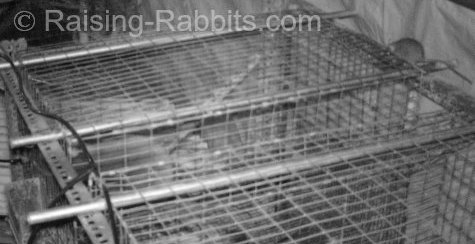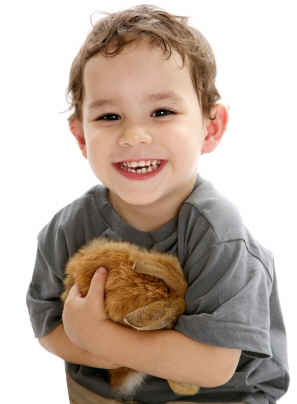| Back to Back Issues Page |
 |
|
Rabbit Rhythm #046 – Rats in the feeders! Plus new facts about rabbits and more February 23, 2014 |
Rabbit Rhythms of MarchOh RATS!! Yes, rats - in the rabbit feeders. I went into the barn a couple weeks ago and found rat droppings in the feeders. Not only was I not happy, I was very annoyed at my barn cats for apparently sleeping on the job!
I immediately purchased a trail cam so I could spy on the little thief or thieves during the night. It took days of surveillance before I finally witnessed what was happening: a rat was running along the top tier of my metal rabbit hutch frames. It was able to squeeze into the 1"x2" cage wire from the back, running past a mostly unfazed rabbit to scarf down the rabbit pellets. The bottom cages seem to be rat-free, possibly because of the drop pans resting on the top of the bottom tier cages. But then why is the rat not entering the bottom tiers from the front of the cages where the drop pans are 12 inches above the cages? Could it be due to the presence of the cats which lurk in the center aisle of the rabbit barn? I don't yet know. I cannot allow the rats to get into the cages! Their droppings almost certainly contain pathogens. Additionally, if rats can get into the cages, then they will also get into the rabbit nest boxes and help themselves to the tiny newborn kits. Being as this problem is a first for me, I am learning as I go. Have you ever had problems with rats in your cages?? If yes, please go to the Raising-Rabbits facebook page and let us (and the rabbit community) know how you solved the problem! In the meantime, I’ve covered the tops of the upper cages with empty feed sacks. So far so good, though since the cage tops aren’t completely covered, I rather expect the rats to wise up eventually. I will also obtain some live traps as well as some homemade affairs that should prove more lethal - involving large tanks of water and bait suspended just out of reach. I don’t plan to use poison. I’d hate for my cats or chickens to eat a poisoned rat and then themselves to die. I’ll provide updates either here or on the Raising-Rabbits facebook page. In the meantime, please offer your tips!
Healthy RabbitsFacts about RabbitsThere's a new page on the Raising-Rabbits website!Our Facts about Rabbits page offers detailed info on EIGHT pet rabbit facts. These in turn are based either on scientific inquiry or extensive experience.
For example, should you get your child a big rabbit or a little one? The second fact about rabbits answers this question. 2 - The best rabbit for a child has more to do with a gentle personality and less to do with size. Should kids get a big rabbit or a little one? One line of reasoning suggests that if a child receives a very large rabbit, he will not be able to pick it up, and therefore the rabbit stays safer. Which begs another question: How safe is a rabbit if the kid can pick up only half of it? Before you know it, the rabbit’s back is broken, and the child has deep scratches. If a child receives a small rabbit, the reasoning continues, the child could more easily manhandle it, possibly killing it accidentally. According to this train of thought, a broken back is preferable to sudden death. Actually, the choice of what size or breed of pet rabbit to obtain depends purely on yours or the child's preference; you can safeguard the rabbit and the child through supervision for as long as necessary. Larger rabbits do tend to be more laid back, though plenty of smaller rabbits are gentle enough for a child. Getting a gentle rabbit, along with supervision at the outset of pet ownership (and keeping the rabbit's claws trimmed!) will help avert accidental injury to the new pet rabbit or to the child, and will ensure the child can be trusted to play comfortably with the rabbit. Some of the other main points are:
Rabbits in the NewsGardening and More: Five tips to keep deer and rabbits away from your garden this winterBy now, if you aren’t completely snowed under, you may be noticing an influx of deer or rabbits into your yard or garden. Both of these species survive the cold winters by gnawing on bark, since their entire menu is dead and buried under a blanket of snow and ice. This Springville Journal article has some great tips on discouraging their visits, even training them to stay away. Like this newsletter?Maybe your friends would too...
Your friends at Raising-Rabbits.com wish you a wonderful March 2014. Enjoy your rabbits!
|
| Back to Back Issues Page |

